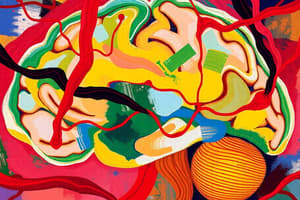Podcast
Questions and Answers
What are the general features associated with ischemic stroke and intracranial hemorrhage (ICH)?
What are the general features associated with ischemic stroke and intracranial hemorrhage (ICH)?
The general features include loss of consciousness (LOC), vomiting, seizures, and headache (HA).
Describe the clinical implications of a middle cerebral artery (MCA) stroke.
Describe the clinical implications of a middle cerebral artery (MCA) stroke.
An MCA stroke can cause contralateral weakness affecting the face and arm more than the leg, along with possible aphasia and sensory neglect.
What are the typical features of lacunar syndromes in stroke patients?
What are the typical features of lacunar syndromes in stroke patients?
Lacunar syndromes often present as pure motor, pure sensory, sensorimotor, ataxic hemiparesis, or dysarthria-clumsy hand syndrome.
What are the key principles of acute ischemic stroke care?
What are the key principles of acute ischemic stroke care?
List the imaging and blood work investigations recommended for stroke diagnosis.
List the imaging and blood work investigations recommended for stroke diagnosis.
What is the target blood glucose level for managing hyperglycemia in stroke patients?
What is the target blood glucose level for managing hyperglycemia in stroke patients?
When should thrombolysis be administered in the case of ischemic stroke?
When should thrombolysis be administered in the case of ischemic stroke?
What medication is recommended for daily use in patients post-stroke management?
What medication is recommended for daily use in patients post-stroke management?
What is the recommended blood pressure reduction strategy for patients with an SBP > 220 mmHg?
What is the recommended blood pressure reduction strategy for patients with an SBP > 220 mmHg?
Why is it important to evaluate for other causes of intracerebral hemorrhage (ICH) in elderly patients?
Why is it important to evaluate for other causes of intracerebral hemorrhage (ICH) in elderly patients?
What should be avoided in the first 48 - 72 hours post-ICH treatment?
What should be avoided in the first 48 - 72 hours post-ICH treatment?
What is a common cause of cardioembolic strokes?
What is a common cause of cardioembolic strokes?
What are neurologic symptoms in cardioembolic stroke characterized by?
What are neurologic symptoms in cardioembolic stroke characterized by?
What does a stroke syndrome that involves a large artery territory and cortical involvement suggest?
What does a stroke syndrome that involves a large artery territory and cortical involvement suggest?
What CHADS2 score indicates a need for anticoagulation in patients with atrial fibrillation?
What CHADS2 score indicates a need for anticoagulation in patients with atrial fibrillation?
What is the target INR range for patients with cardioembolic stroke receiving anticoagulation?
What is the target INR range for patients with cardioembolic stroke receiving anticoagulation?
What does a HAS-BLED score of ≥ 3 signify in the context of anticoagulation?
What does a HAS-BLED score of ≥ 3 signify in the context of anticoagulation?
Identify a common complication of stroke related to the central nervous system (CNS).
Identify a common complication of stroke related to the central nervous system (CNS).
What role does physiotherapy play in stroke rehabilitation?
What role does physiotherapy play in stroke rehabilitation?
What scoring system is used for risk stratification after a TIA?
What scoring system is used for risk stratification after a TIA?
What lifestyle modification can be beneficial for secondary prevention of stroke?
What lifestyle modification can be beneficial for secondary prevention of stroke?
What characterizes an episode classified as a transient ischemic attack (TIA)?
What characterizes an episode classified as a transient ischemic attack (TIA)?
What are the primary classifications of cerebrovascular disorders according to the ICD system?
What are the primary classifications of cerebrovascular disorders according to the ICD system?
What is the key difference between a stroke and a transient ischemic attack (TIA)?
What is the key difference between a stroke and a transient ischemic attack (TIA)?
Identify the two main types of strokes and their approximate prevalence.
Identify the two main types of strokes and their approximate prevalence.
Explain the role of hypertension in stroke risk as exemplified in the cases provided.
Explain the role of hypertension in stroke risk as exemplified in the cases provided.
Explain the difference between a completed stroke and a progressive stroke.
Explain the difference between a completed stroke and a progressive stroke.
List two non-modifiable and two modifiable risk factors for stroke.
List two non-modifiable and two modifiable risk factors for stroke.
Describe the clinical presentation of a patient experiencing a right facial nerve palsy due to stroke.
Describe the clinical presentation of a patient experiencing a right facial nerve palsy due to stroke.
What are common symptoms of a patient experiencing an intracerebral hemorrhage (ICH)?
What are common symptoms of a patient experiencing an intracerebral hemorrhage (ICH)?
What is the role of chronic hypertension in causing hemorrhagic stroke?
What is the role of chronic hypertension in causing hemorrhagic stroke?
What are the primary mechanisms through which hemorrhagic stroke disrupts neuronal activity?
What are the primary mechanisms through which hemorrhagic stroke disrupts neuronal activity?
Identify the features that distinguish an ischemic stroke from a hemorrhagic stroke.
Identify the features that distinguish an ischemic stroke from a hemorrhagic stroke.
What is the Glasgow Coma Scale (GCS) and why is it important in evaluating stroke patients?
What is the Glasgow Coma Scale (GCS) and why is it important in evaluating stroke patients?
Define the term 'cerebral venous thrombosis' and its consequence.
Define the term 'cerebral venous thrombosis' and its consequence.
What is the significance of the Circle of Willis in relation to blood supply to the brain?
What is the significance of the Circle of Willis in relation to blood supply to the brain?
What is the significance of a positive Kernig's sign in a neurological examination?
What is the significance of a positive Kernig's sign in a neurological examination?
Flashcards are hidden until you start studying
Study Notes
Stroke Overview
- Stroke is characterized by rapidly developing signs of focal or global cerebral function disturbances, lasting over 24 hours or leading to death, of vascular origin.
- Transient Ischemic Attack (TIA) is a temporary episode of focal neurological dysfunction, lasting from 2 to 24 hours, without permanent deficits.
Case Studies
- Mr. AZ (70 years old):
- History of hypertension (HTN) and type 2 diabetes mellitus (T2DM)
- Found unresponsive; Glasgow Coma Scale (GCS) 8/15, anisocoria, left facial deviation, and no motor response on the right side.
- Mrs. BY (65 years old):
- Good adherence to T2DM medication.
- Sudden onset slurred speech and inability to walk; GCS 15/15, right facial nerve palsy, and marked motor deficits.
- 42-year-old male:
- Sudden severe headache with vomiting, LOC, GCS 14/15, and positive Kernig's sign; no motor deficits.
Stroke Classification
- Classified into ischemic stroke (80%) and hemorrhagic stroke (20%).
- Ischemic Stroke:
- Thrombotic (50%) and embolic (30%).
- Hemorrhagic Stroke:
- Intracerebral hemorrhage (15%) and subarachnoid hemorrhage (5%).
Risk Factors
- Non-modifiable: Age, race, male gender, family history.
- Modifiable: Hypertension, diabetes mellitus, smoking, alcohol consumption, dyslipidemia, physical inactivity, cardiac risk factors, and other conditions (e.g., vasculitis).
Hemorrhagic Stroke Causes
- Chronic hypertension, arteriovenous malformations (AV malformations), amyloid angiopathy, anticoagulant therapy, amphetamines, and drugs like cocaine.
Pathophysiology
- Ischemic Stroke: Due to lack of blood supply leading to neuron death.
- Hemorrhagic Stroke: Blood entry into the brain disrupts neuronal activity, causing increased intracranial pressure, edema, and potential herniation.
Clinical Features
- Common symptoms include loss of consciousness (LOC), vomiting, and headache.
- Middle Cerebral Artery (MCA) strokes often cause contralateral weakness and aphasia.
- Posterior Cerebral Artery (PCA) strokes may present with homonymous hemianopia.
Investigations
- Non-enhanced CT brain, blood work (including glucose and lipid profile), ECG, and potential carotid Doppler imaging for ischemic strokes.
Acute Ischemic Stroke Management
- Timely recanalization of occluded arteries is critical.
- Treatment includes thrombolysis within 3-4.5 hours of onset, antiplatelet therapy, and controlling hyperglycemia.
Management of Intracerebral Hemorrhage
- Rapid evaluation using non-contrast CT and managing blood pressure to prevent hematoma expansion.
- Avoidance of NSAIDs and careful use of anticoagulants within the acute phase.
Cardioembolic Stroke
- Often caused by atrial fibrillation; stroke prevention includes anticoagulation based on risk stratification scores like CHADS2 and CHA2DS2-VASc.
Secondary Stroke Prevention
- Lifelong antiplatelet therapy and statin usage post-ischemic stroke.
- Lifestyle modifications and rehabilitation through physiotherapy, occupational therapy, and speech therapy.
Complications of Stroke
- Include recurrent strokes, seizures, pulmonary complications, deep vein thrombosis (DVT), and psychological issues such as depression.
Risk Stratification for TIA
- ABCD2 score to assess stroke risk following TIA; includes age, blood pressure, clinical features, duration of symptoms, and diabetes presence.
- Neuroimaging (MRI) is suggested for further evaluation in suspected TIA patients.
Studying That Suits You
Use AI to generate personalized quizzes and flashcards to suit your learning preferences.



